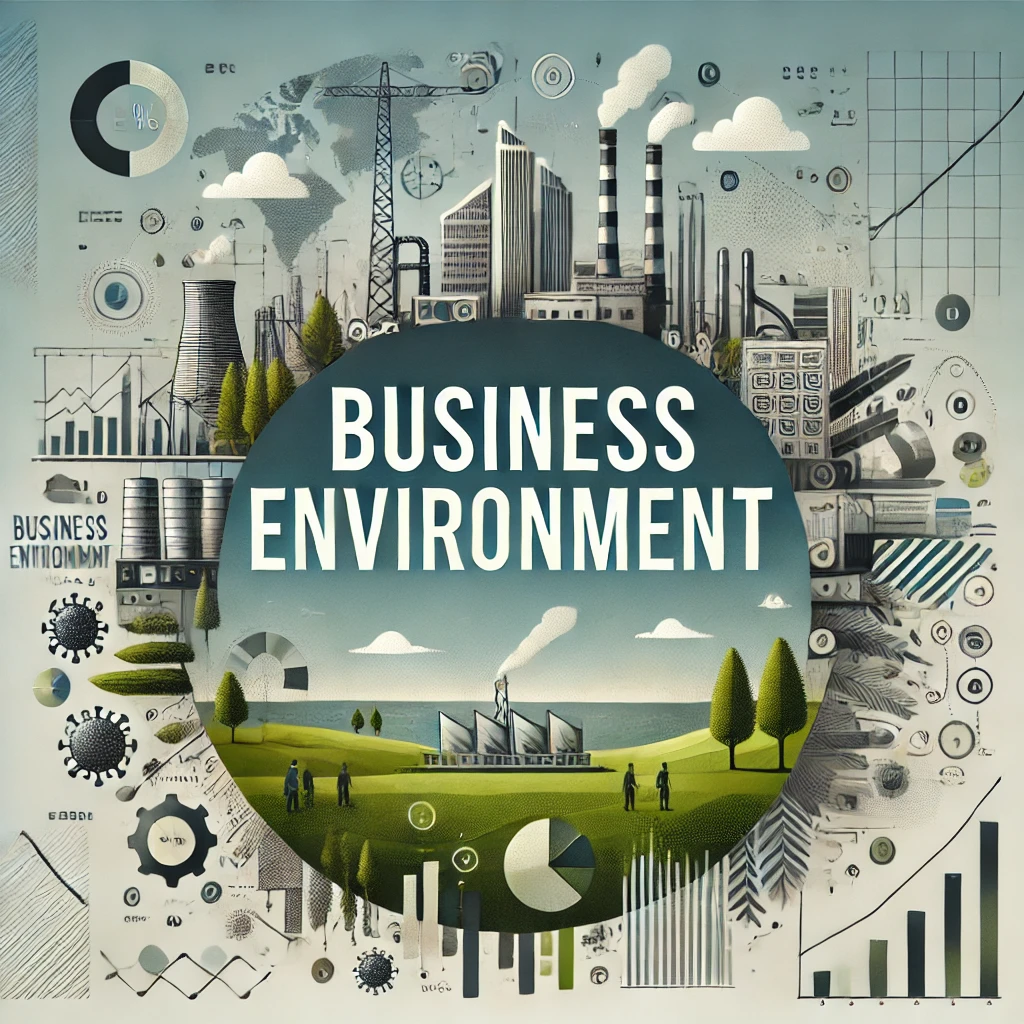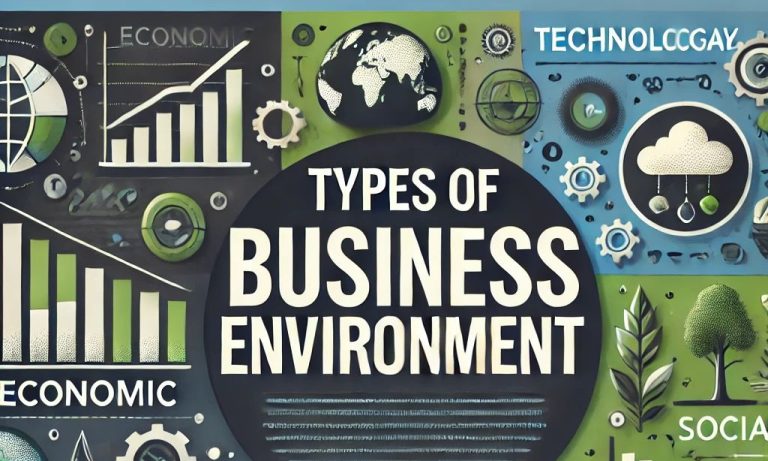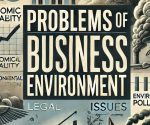What are the types of business environment? A business environment comprises external factors affecting the operations and outcomes of an organization. The conditions, forces, and institutions responsible for changes in the business environment have to be recognized. As such, recognizing these kinds of business environments forms a basis for businesses how to adjust, strategize, and make decisions about what to do to improve performance and grow. These environmental elements might be opportunities or challenges for business. It discusses various forms of the business environment, its characteristic features, and how businesses may be affected.
What is Business Environment?
The business environment is the combination of external and internal factors that affect the functioning and decision-making of businesses. These factors can include economic conditions, political climate, social trends, technological advancements, legal frameworks, and competitive pressures. The business environment can be classified into two categories:
A healthy business environment is essential for growth, while a negative or unstable environment can hinder progress. Therefore, businesses must understand and adapt to their environment to stay competitive and resilient.
Types of Business Environment
The types of business environment can be broadly categorized into internal and external environments, but the external business environment is more complex and diverse. It includes the following key types:
Economic Environment
The economic environment refers to the economic conditions that affect the business activities of a company. Economic factors directly impact consumer spending, business investment, and profitability. Businesses need to monitor economic trends to predict how they may affect demand for their products or services.
- Economic Growth: A growing economy encourages businesses to expand, while a contracting economy may force businesses to cut costs.
- Inflation Rates: High inflation can reduce purchasing power, affecting sales, while deflation can lead to lower prices and decreased profits.
- Interest Rates: High interest rates make borrowing expensive, which can discourage investment.
- Currency Fluctuations: Exchange rate fluctuations can impact international trade and profitability.
Technological Environment
The technological environment consists of the advancements in technology that can impact the way businesses operate. Technological changes can introduce new tools, processes, and systems that improve productivity and efficiency. On the other hand, businesses that fail to adapt to technological changes risk falling behind their competitors.
- Innovation: New technologies can open up new market opportunities and lead to the development of new products or services.
- Automation: Advances in automation can reduce labor costs and improve operational efficiency.
- Cybersecurity: With the rise of digital platforms, businesses must also focus on protecting themselves from cyber threats and data breaches.
- Research and Development (R&D): Investing in R&D helps businesses stay competitive by developing new products and services.
Political and Legal Environment
The political and legal environment refers to the government policies, regulations, and political stability that influence business activities. This environment includes laws related to labor, health and safety, taxation, environmental protection, and intellectual property. Political decisions and legal frameworks play a critical role in shaping business operations, especially in regulated industries.
- Government Policies: Policies on taxation, trade, and subsidies can impact business profitability and competitiveness.
- Legal Regulations: Laws related to labor, consumer protection, and environmental standards can affect business operations and costs.
- Political Stability: Political instability can create uncertainty, which may negatively affect investor confidence and business activities.
- International Relations: Trade agreements and diplomatic relations influence how businesses interact with foreign markets.
Social and Cultural Environment
The social and cultural environment refers to the social factors, values, norms, and cultural aspects that influence consumer behavior and business operations. This environment affects market trends, customer preferences, and even the availability of skilled labor.
- Demographic Factors: Age, gender, income, education, and family structure affect market demand for products and services.
- Lifestyle Changes: Shifting lifestyles and values impact consumer purchasing decisions, such as a growing demand for health-conscious products.
- Cultural Trends: Businesses must be sensitive to cultural norms and practices when marketing their products, especially in international markets.
- Social Movements: Movements related to sustainability, equality, and human rights can shape public perception and demand for responsible business practices.
Competitive Environment
The competitive environment refers to the intensity of competition within an industry or market. The level of competition affects pricing strategies, marketing efforts, and innovation. Companies must keep a close eye on their competitors to adapt their strategies and gain a competitive advantage.
- Number of Competitors: A higher number of competitors can lead to price wars, which may affect profitability.
- Market Share: Businesses need to analyze their market share relative to competitors to develop effective strategies.
- Barriers to Entry: High barriers to entry, such as capital requirements or brand loyalty, can protect established businesses from new competition.
- Competitive Advantage: Differentiation through product quality, customer service, and innovation helps businesses stand out in a crowded market.

Features of Business Environment
The features of business environment are crucial in understanding its impact on business decisions and strategies. These features help businesses adapt and respond to external and internal challenges effectively.
- Dynamic Nature: The business environment is constantly changing, influenced by factors such as technological advancements, changing consumer preferences, and government policies. Businesses must stay agile and adaptable to these shifts to maintain their competitiveness.
- Complexity: The business environment is complex due to the presence of various interrelated factors. These factors, whether political, economic, or technological, can impact businesses in unpredictable ways. Companies must consider all aspects of the environment when making decisions.
- Uncertainty: Due to the dynamic nature of the business environment, there is always an element of uncertainty. For example, changes in government policies or sudden economic downturns can affect a company’s plans. Businesses must plan for uncertainty by diversifying risks and being prepared for sudden changes.
- Interdependence: Different elements of the business environment are interdependent. Changes in one area (e.g., economic conditions) can have a ripple effect on other areas (e.g., consumer behavior). Businesses need to understand these interdependencies to make informed decisions.
- Global Influence: In today’s interconnected world, businesses are affected by global factors. International trade, global supply chains, and cross-border policies influence business strategies. Companies must consider the global environment when operating, especially in the case of multinational corporations.
Conclusion
Understanding what are the types of business environment is vital for any business. It allows companies to identify opportunities, manage risks, and stay competitive in the ever-changing global market. The economic, technological, political, social, and competitive environments all play critical roles in shaping business strategies. By recognizing the features of business environment, businesses can plan better, adapt faster, and make informed decisions to achieve long-term success.
Business Environment FAQs
What are the types of business environment?
The types of business environment include the economic environment, technological environment, political and legal environment, social and cultural environment, and competitive environment.
What is the role of the economic environment in business?
The economic environment affects factors such as inflation, interest rates, and economic growth, which influence consumer spending and business investment decisions.
How does the political environment affect businesses?
The political environment shapes business activities through government policies, taxation, legal regulations, and political stability, impacting profitability and business operations.
What are the features of business environment?
The features of business environment include its dynamic nature, complexity, uncertainty, interdependence of factors, and global influence on business decisions.
How do changes in social trends impact business?
Changes in social trends, such as shifts in consumer preferences or lifestyle changes, affect market demand, product offerings, and marketing strategies for businesses.


